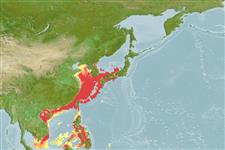Common names from other countries
Classification / Names / Names
ชื่อสามัญ | ชื่อพ้อง | Catalog of Fishes (gen., sp.) | ITIS | CoL | WoRMS
Environment: milieu / climate zone / depth range / distribution range
นิเวศวิทยา
สัตว์น้ำที่อาศัยและอพยพภายในทะเลเท่านั้น (Ref. 75927); ระดับความลึก 10 - 150 m (Ref. 275), usually 60 - 150 m (Ref. 75927). Subtropical; 15°C - 25°C (Ref. 75927); 41°N - 6°N, 104°E - 138°E (Ref. 1695)
Western Pacific: South and East China seas, Japan to Philippines and Indonesia.
Length at first maturity / ขนาด / น้ำหนัก / Age
Maturity: Lm ? range ? - ? cm Max length : 18.0 cm ML เพศผู้/กระเทย; (Ref. 275); น้ำหนักสูงสุดที่มีการรายงาน: 600.00 g (Ref. 1695)
Caught by otter trawls, pound nets, hoop nets and hook-and-line (Ref. 346). Sometimes found burrowing in the substrate (Ref. 275).
Life cycle and mating behavior
วัยเจริญพันธุ์ | การสืบพันธุ์ | การวางไข่ | เซลสืบพันธ์ของเพศเมีย(ไข่) | ความดกของไข่ | ตัวอ่อน
Members of the class Cephalopoda are gonochoric. Male and female adults usually die shortly after spawning and brooding, respectively. Mating behavior: Males perform various displays to attract potential females for copulation. During copulation, male grasp the female and inserts the hectocotylus into the female's mantle cavity where fertilization usually occurs. Life cycle: Embryos hatch into planktonic stage and live for some time before they grow larger and take up a benthic existence as adults.
Roper, C.F.E., M.J. Sweeney and C.E. Nauen. 1984. (Ref. 275)
IUCN Red List Status (Ref. 130435)
CITES status (Ref. 108899)
Not Evaluated
Not Evaluated
Human uses
การประมง: การค้า
| FishSource |
เครื่องมือ
แหล่งที่มาจากอินเตอร์เน็ต
Estimates based on models
Preferred temperature
(Ref.
115969): 11.6 - 23.2, mean 18.5 (based on 195 cells).
Prior r = 0.31, 95% CL = 0.20 - 0.47, Based on 1 full stock assessment.
Vulnerability
Low vulnerability (10 of 100).
